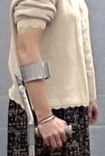Crutches: Basic Guide

Crutches help to take weight off one leg (completely or partially). The two most common types of crutches are: Axillary Crutches and Forearm Crutches
Measuring

When standing tall with arms at the side, adjust the crutch height so that 2 fingers can fit between the armpit and the axilla pad. Adjust the handle to wrist level so that the elbow is slightly bent when using the crutches.

Forearm Crutches Adjustment

When standing tall with arms at the side, adjust the crutch height so that the handles are level with the wrists. While holding the handles, adjust the cuffs to a comfortable position (just below the elbows).
How to hold forearm crutches
With the handles facing forward, slide the forearms into the cuffs and grasp the handles.
How to walk with crutches:
No weight through the affected leg
- Place the crutches one step length forward
- Support body weight through the arms and swing the sound leg forward (one step length past the crutches)
- Repeat the pattern
Partial weight through the affected leg
- Place the crutches one step length forward
- Support body weight through the arms and swing the sound leg forward (one step length past the crutches)
- Repeat the pattern
Going up & down stairs:
Going up stairs: "Up with the good"
- Place the sound leg up one step
- Bring the crutches and affected leg up onto the same step as the sound leg
- Repeat the pattern
Going down stairs: "Down with the bad"
- Place the crutches and affected leg down one step
- Bring the sound leg down onto the same step
- Repeat the pattern
How to do stairs with a railing:
Use the same pattern as with two crutches. The crutch that is not being used can be carried: at right angles to the other crutch or side by side as one


